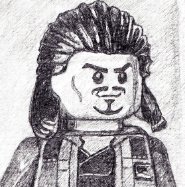Essays, Not Rants! 118: The Dynamics of the Buddy Movie
Im on vacation. As such, heres an essay I wrote for class during my Spring semester. We were assigned seven movies and had to compare the lot of them. Hence writing about The Parent Trap. Enjoy.
The buddy movie is one of the most prolific genres in cinema. With movies as diverse as the classic Butch Cassidy and the Sundance Kid, recent blockbusters like The Avengers, and animated films such as Toy Story; chances are everyones seen some variation of a buddy movie. One of the things that keeps the genre timeless is the myriad of buddies they can feature. We could have four characters who start out as friends and have their friendship tested, or they could be rivals who learn to work together. Alternately it could feature a pair of old friends who decide to roam the world together, possibly saving it in the progress; or two people with opposite personalities and a common goal. Point is, these different character dynamics are what make the genre unique.
At its basest the buddy movie genre allows for two characters to work together towards a similar goal. Such is the case with The Parent Trap. Annie and Hallie, the long-lost twins, are essentially the same character, though in English and American forms. The first portion of the film focus on them meeting, disagreeing, and coming to terms with each other whereas the remainder of the film follows them as they strive to reunite their parents. Here the characters compliment each other, their shared goal and similar personalities allow them to work together perfectly to achieve this goal.
Of course, thats just one personality. Things get more interesting when more personalities are in play. The ancient Greeks put forth the theory of the four humors; that is that personalities could be divided into four temperaments: sanguine, choleric, melancholic, and phlegmatic. The definition of these fall on different ranges, being extroverted and people-orientated, extroverted and task-orientated, introverted and task-orientated, and introverted and people-orientated; respectively. Writers and viewers can use these to identify the roles characters have in a group. Take Sex and the City as a key example. Carrie, the main character, tends to be introverted and focused on her work (within the film shes not seen as being terribly outgoing). Samantha on the other hand, is much more extroverted and focused on the people around her, as seen by her frequent flying from California to New York to visit her friends as well as her constant interest in the people (particularly men) around her. Miranda and Charlotte fall between choleric and phlegmatic respectively. When the buddy movie features an ensemble of four, each character will usually embody one of these temperaments. These contrasts allow for tension to build between the characters and conflict among them which, in addition to the central conflict, makes for an interesting story.
The titular foursome of Fantastic Four fit these roles with near perfection. Reed Richards is the cool, collected, melancholic leader of the group; he wants to create a machine to reverse their transformation. Ben Grimm too is task-orientated, though tends to be more outgoing and fulfills the role of the choleric. Johnny Storm is even more extroverted than Ben and lives for the attention of people around him so he clearly is the sanguine member. Lastly, Sue Storm is the mediator of the three focused more on the team themselves and falls under the heading of the phlegmatic. The Fantastic Four fit the temperaments and with it conflict is born.
Johnny, the sanguine, is eager to embrace his powers and go public with them. Reed, however, wants to not only make sure theyre safe but to reverse them. Here we see the tension between Johnnys people-orientated nature and Reeds tendency to pursue tasks. This same dichotomy is where a measure of the romantic tension between Reed and Sue stems from: his want to finish his machine and undo the effects of the cosmic storm and her want for him. Its when Reed pursues her and momentarily abandons his focus on the task on hand that strain between him and Ben develops. Many of the films key moments, the incident on the Brooklyn Bridge and the fight outside the stadium, for example, are born out of the tension between these personality types. Its only when they learn to work together that they are able to beat the villainous Victor von Doom and truly become heroes.
Removing one character from the foursome creates a different dynamic, one which website TV Tropes dubs the Power Trio. In this set up the three characters contrast and compliment each other, often (but not necessarily) with each one embodying one aspect of the Freudian ideas of the id, ego, and superego. The id is wild and impetuous, frequently jumping headfirst into situations; the superego is the ids foil, rational and willing to look before leaping. The ego exists between them, balancing out their extremes. It can be seen in the original Star Trek TV show, with Kirk balancing out the hyper-rational Spock and the instinctive McCoy.
This also serves as a lens to look at Harry, Ron, and Hermiones relationship in Harry Potter and the Prisoner of Azkaban. Harry is clearly the id of the trio; when he accidentally makes Aunt Marge float he doesnt think twice about leaving home and charging out into the night. We see this aspect of him again later when, upon hearing that Sirius Black betrayed his parents, he adamantly declares that he will kill the convict. On the opposite end of the spectrum, assuming the role of the superego, is Hermione. She is heavily focused on her studies, going so far as to have one of her professors procure her a time-turner so she can take a large number of classes. Furthermore, she is also the most sensible of the group, often exhorting the other two to calm down and listen to reason lest they get themselves hurt or in trouble at school. Ron stands between them as the ego. Sometimes ###### be as headstrong as Harry, other times hes with Hermione trying to talk down Harry from doing something reckless.
Though theres little infighting amongst the threesome (especially compared to, say, the Fantastic Four), their differing personalities still serve to accentuate each others traits. Harry and Rons laid back attitudes sharpen Hermiones studious nature, just as Hermiones tendency to sit back and figure things out contrasts against Harrys impulsiveness. The different views that Harry, Ron, and Hermione bring to the table enhance the characters and give their interactions and by proxy their adventure a great dynamic. It can also be seen in the key adults at the end of the film, with wild Sirius Black as the id, the mediating Remus Lupin as ego, and calculating Severus Snape the superego.
Narrowing the number of characters further results in foils; two characters who may share a similar goal but contrast sharply with each other. In Kinky Boots the tight-laced, somewhat-sheltered Charlie Price is paired up with the vivacious drag queen Lola. Their differing personalities clash on occasion, primarily over the subject of Lolas identity. Charlie wants her to hide who she is in Northampton for fear that people will think ill of him, whereas shes proud of her identity. The tension between their points of view and what they represent colors much of the films tension and the themes of acceptance and coming to terms with your identity.
Alternately, one character can influence the other. In Fried Green Tomatoes, the straight-laced Ruth becomes friends with the wild Idgie when asked to by the latters family. Over time, Ruth opens up to Idgies adventurous life and their friendship grows. Their differences help each other: its Idgies feisty boisterousness that causes her to get Ruth out of her abusive relationship with Frank; and its Ruths level headedness and warmth that help give Idgie a home. Theyre opposites, yes, but their personalities compliment and strengthen each other, making for a compelling dynamic.
Another common incarnation of the buddy movie is the buddy cop movie. The conceit usually incorporates two police officers of contrasting personalities and, frequently, different races who have been ordered to work together. Films like Rush Hour, BZP Lovers, and End of Watch have done this to great commercial success. Lethal Weapon too was a commercial success and is unquestionably the quintessential example of a typical buddy cop movie.
Like other buddy twosomes, Martin Riggs and Roger Murtagh are opposites. Riggs is young, white, impulsive, and somewhat suicidal. Murtagh is middle-aged, black, reserved, and has a wife and kids to worry about. What Lethal Weapon, and other buddy cop movies, does is accentuate these differences to near extremes and forces them, by virtue of orders from their chief, to work together. This handy trope explains why the two opposites have to be together and provides the catalyst for the inevitable fights between the two.
And fight they do. From their initial meeting, Riggs and Murtagh find themselves at odds with each other. Something as non-dangerous as dealing with a jumper displays their different approaches: Murtagh stays near the car and tries to talk him down whereas Riggs climbs up to the jumper, cuffs themselves together, and jumps off onto the inflatable bag with him. This conflict amongst the cops compliments their struggle against the antagonists. It's only when they are finally able to reconcile their differences and work as a team that they are able to defeat the bad guys, as we see in the iconic moment when Riggs and Murtagh shoot the villain Joshua together.
The buddy movie is a genre as diverse as its characters. Different combinations, be they based off the four temperaments, embodiments of Freudian ideas, or plain old opposites provide interesting dynamics that add an additional layer to the conflict and tension not usually found in other, single protagonist films.
-
 1
1



0 Comments
Recommended Comments
There are no comments to display.